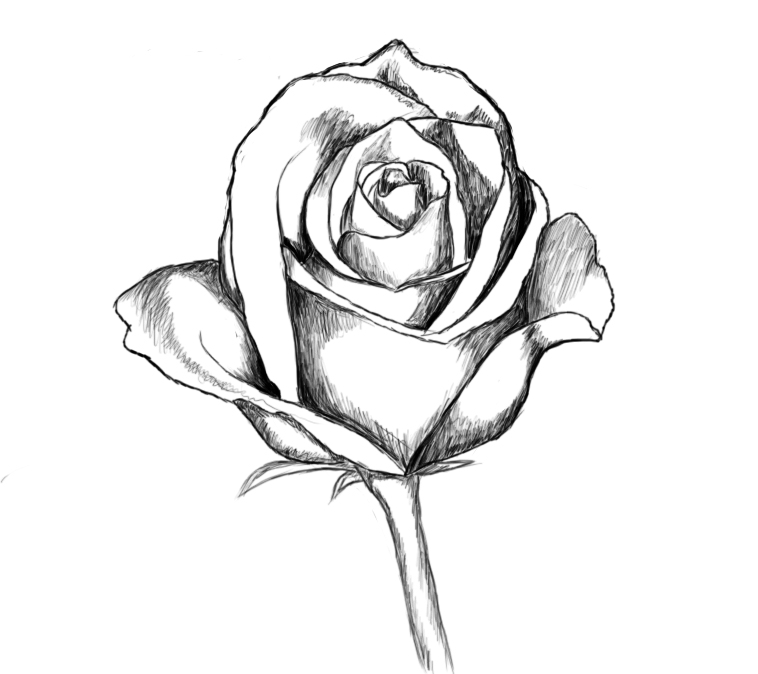Rose drawing is a timeless skill that combines creativity and technique, making it a beloved subject for artists of all levels. Whether you're an aspiring artist or someone looking to explore a new hobby, learning how to draw roses can be incredibly rewarding. In this article, we will delve into the intricacies of rose drawing, providing you with the tools and techniques you need to create stunning floral illustrations.
In the following sections, we will cover everything from the basic anatomy of a rose to advanced shading techniques, ensuring that you have a comprehensive understanding of this beautiful flower. Additionally, we will discuss the materials you'll need, common mistakes to avoid, and tips for improving your drawing skills effectively. By the end of this article, you will feel confident in your ability to capture the elegance of roses on paper.
So grab your pencils and sketchbooks, and let's dive into the world of rose drawing!
Table of Contents
- Understanding the Anatomy of a Rose
- Essential Materials for Rose Drawing
- Basic Techniques for Drawing Roses
- Advanced Shading Techniques
- Common Mistakes to Avoid
- Tips for Practicing Rose Drawing
- Finding Inspiration for Your Drawings
- Conclusion
Understanding the Anatomy of a Rose
Before you start drawing, it’s essential to understand the basic structure of a rose. A rose consists of several components that contribute to its overall appearance:
- Petals: The delicate, colorful parts of the flower that attract attention.
- Sepals: The green leaf-like structures that protect the bud before it blooms.
- Stamen: The male reproductive part consisting of anther and filament.
- Pistil: The female reproductive part made up of the ovary, style, and stigma.
By familiarizing yourself with these components, you will be better equipped to draw a realistic rose. Observing real roses or high-quality photographs can provide further insight into their unique features.
Essential Materials for Rose Drawing
Having the right materials is crucial for successful rose drawing. Here’s a list of essential items you should consider:
- Pencils: A range of pencils (2H to 6B) for different shading effects.
- Paper: Smooth drawing paper or sketchbooks suitable for pencil work.
- Eraser: A kneaded eraser for gentle lifting of graphite.
- Blending Stumps: For smooth shading and blending techniques.
Investing in quality materials can significantly improve the outcome of your drawings. Experiment with different brands and types to find what works best for you.
Basic Techniques for Drawing Roses
Now that you’re equipped with the necessary materials, it’s time to explore some basic techniques for drawing roses:
1. Sketching the Outline
Begin with a light pencil to sketch the basic shape of the rose. Focus on the overall form, including the circular arrangement of the petals.
2. Adding Petal Details
Once the outline is in place, start adding details to the petals. Observe how they curve and overlap, creating dimension.
3. Incorporating Leaves and Stem
Don’t forget to include leaves and the stem in your drawing. They add context and balance to the overall composition.
Advanced Shading Techniques
Shading is what brings your rose drawing to life. Here are some advanced techniques to consider:
1. Layering
Start with light layers of graphite and gradually build up darker tones. This adds depth and realism to your petals.
2. Cross-Hatching
Use cross-hatching to create texture and shadow. This technique involves drawing intersecting lines to indicate darker areas.
3. Blending
Utilize blending stumps or your fingers to smooth out harsh lines and create soft transitions between light and dark areas.
Common Mistakes to Avoid
Every artist makes mistakes, but being aware of common pitfalls can help you improve:
- Overworking the Paper: Be careful not to press too hard, as this can damage the paper.
- Neglecting Proportions: Ensure your rose is proportionate by frequently comparing different parts.
- Skipping References: Always use references to improve accuracy and detail in your drawings.
Tips for Practicing Rose Drawing
To become proficient in drawing roses, regular practice is essential. Here are some tips:
- Set aside time each week to focus solely on drawing roses.
- Experiment with different styles, such as realistic, abstract, or stylized roses.
- Join online art communities to share your work and receive constructive feedback.
Finding Inspiration for Your Drawings
Inspiration can come from various sources. Consider these ideas:
- Visit botanical gardens or flower shops to observe real roses.
- Explore social media platforms like Instagram and Pinterest for creative rose drawings.
- Look for art books that showcase floral illustrations for reference.
Conclusion
In conclusion, mastering rose drawing is a journey that involves understanding the flower's anatomy, using the right materials, and practicing various techniques. By avoiding common mistakes and seeking inspiration, you can develop your skills and create beautiful rose illustrations. We encourage you to share your progress in the comments below and connect with other aspiring artists.
Thank you for reading! We hope this article inspires you to pick up your pencils and start drawing roses today!
You Might Also Like
Cynthia Blaise: A Journey Through Her Life And CareerKevin Jamal Woods: A Comprehensive Insight Into His Life And Career
Riley Smith: The Rise Of A Versatile Actor And Musician
Exploring The Depths Of China Soul: Understanding The Cultural Essence
Grand Valley Inn: A Comprehensive Guide To Your Stay In Fallston, PA
Article Recommendations
- Rory Feek New Wife
- Salt Trick For Men
- David Lee Roth Daughter
- 7 Movierulz Telugu 2024
- Carrie Underwood Pregnant
- Jason Beghe
- Vegamovies Re Hindi Dubbed
- Christina Aguilera Weight Loss
- Elvis Presley Ethnic Background
- Jane Fonda Short Haircut

